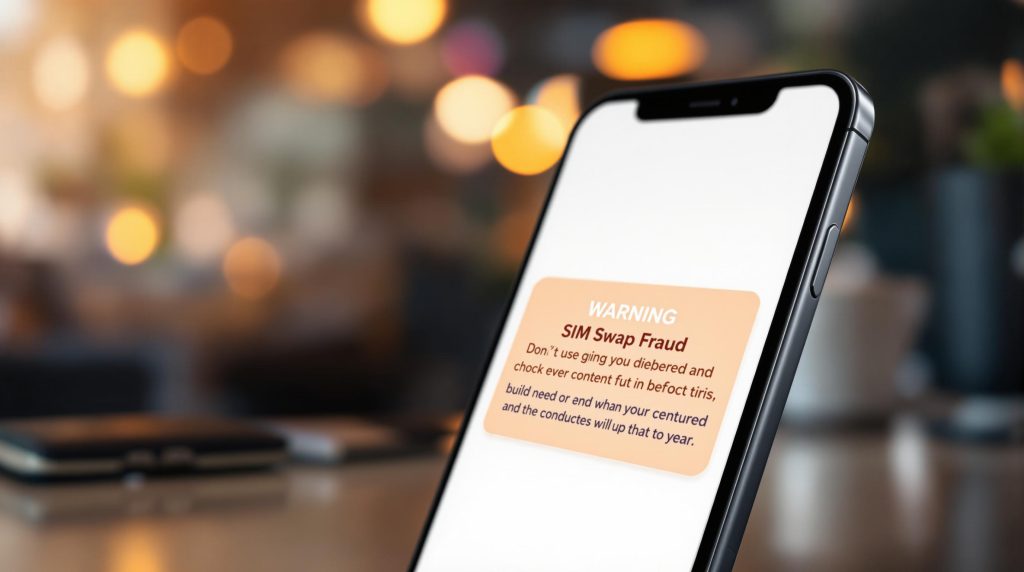SIM swap fraud is when someone steals your phone number by transferring it to a SIM card they control. This lets them access your calls, texts, and SMS verification codes. Why does this matter? Because with your number, they can break into your bank accounts, email, and social media by bypassing two-factor authentication (2FA).
Here’s how it happens:
- Step 1: They gather your personal info (e.g., through phishing or data breaches).
- Step 2: They convince your mobile carrier to transfer your number to their SIM.
- Step 3: They intercept SMS codes, reset passwords, and access your accounts.
How to protect yourself:
- Use authenticator apps or hardware security keys instead of SMS-based 2FA.
- Set up a PIN and alerts with your carrier for SIM changes.
- Keep your main phone number private; consider using temporary numbers for online accounts.
SIM swap fraud is a growing threat, but with the right precautions, you can stay ahead of it.
SIM Swapping Explained – Secure Your Phone and Finances
SIM Swap Attack Methods
SIM swap attacks allow criminals to take control of your phone number. Knowing how these attacks work can help you stay protected.
1. Gathering Personal Information
Attackers collect your personal details using various methods:
- Social Engineering: They dig through your social media accounts to find your name, birthdate, and phone number.
- Phishing Scams: Fraudulent emails or texts disguised as messages from your bank or carrier trick you into sharing account details.
- Data Breaches: Stolen personal information, including security question answers, is often purchased from underground markets.
With this information, they’re ready to initiate a fraudulent SIM transfer.
2. SIM Transfer Tactics
Here’s how criminals execute the transfer:
- Claim your phone is lost or damaged.
- Use the stolen information to impersonate you and verify their identity.
- Request your phone number be transferred to their new SIM card.
- In some cases, they bypass additional security checks.
3. Exploiting the Compromised SIM
Once the transfer is complete, attackers gain control of your number and can:
- Intercept SMS Codes: They receive all your texts and calls, including verification codes.
- Reset Passwords: Use SMS recovery options to take over your email, bank, and social media accounts.
- Bypass Two-Factor Authentication: Accounts protected by SMS verification are now accessible to them.
One way to reduce your risk is by using temporary phone numbers for online services. Disposable SIM-based numbers can keep your personal number private when signing up for websites and apps, adding an extra layer of security.
sbb-itb-5a89343
SIM Swap Attack Dangers
SIM swap attacks can have serious consequences, making it essential to understand how they work and the risks involved.
Financial Loss and Account Breaches
With SIM swap fraud, attackers can intercept SMS verification codes, giving them access to your financial accounts. This can result in immediate theft of funds and unauthorized control over sensitive financial information.
Exposure of Personal Information
When attackers take control of your phone number, they can access accounts linked to it. This puts your personal data and digital identity at risk, increasing the chances of identity theft and long-term privacy issues.
Weaknesses in SMS-Based Security
SMS authentication is particularly vulnerable to SIM swap attacks. Accounts that rely only on SMS codes are at higher risk. To enhance security, using temporary phone numbers for online registrations can help. Services like MobileSMS.io offer an added layer of protection against these types of threats.
SIM Swap Protection Steps
SIM swap fraud poses serious risks, so taking steps to protect yourself is essential.
Protect yourself by using more secure 2FA methods and opting for temporary phone numbers when possible.
Stronger 2FA Methods
SMS-based two-factor authentication can be easily exploited. A better option is to use tools like hardware security keys or authenticator apps (e.g., Google Authenticator) for added security.
Temporary Phone Numbers
Using your personal phone number for verification increases your vulnerability. Instead, consider temporary numbers. Services like MobileSMS.io provide disposable, non-VoIP numbers to keep your personal details private. For ongoing use, long-term rental numbers offer a secure and dedicated alternative.
Summary
Main Security Threats
SIM swap fraud poses a serious risk to your digital safety. Attackers can use it to gain access to banking apps, withdraw funds, and steal sensitive data from email or cloud storage. SMS-based vulnerabilities also give them control over your verification codes, making it easier to compromise your accounts.
Protection Checklist
Take these steps to reduce your risk:
- Carrier Account Security
- Set up a PIN for your account with your mobile carrier.
- Enable voice authentication for an added layer of protection.
- Request alerts for any SIM card changes to stay informed.
- Stronger Authentication
- Move away from SMS-based two-factor authentication and opt for authenticator apps.
- Use hardware security keys whenever they’re an option.
- Enable biometric verification, like fingerprints or facial recognition, if supported.
- Safeguard Your Phone Number
- Use temporary numbers to shield your main phone number. Services like MobileSMS.io offer disposable, non-VoIP numbers for this purpose.
- Keep your primary number private and limit where you share it.
- Regularly monitor your account activity for any unusual behavior.
- Secure Your Accounts
- Use unique, complex passwords for every account.
- Replace SMS-based authentication with authenticator apps or hardware security keys across all platforms.
- Periodically review linked phone numbers and account logs for any unauthorized changes.

